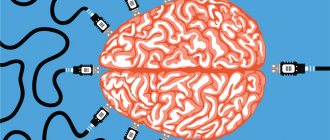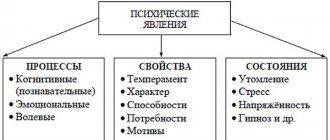Components of communication and its varieties
Components of communication are those components that are not included in the structure of communication.
These include:
- target,
- facilities,
- subjects (participants of interaction),
- type of connection between subjects,
- style,
- tactics,
- techniques, methods,
- result.
Depending on the components, various types and forms of communication are distinguished:
- emotional – exchange of emotions;
- cognitive – knowledge sharing;
- activity - exchange of skills and abilities;
- motivational – exchange of desires and goals;
- material – exchange of objects or products.
Types of social interaction can be defined as its levels. Level – certain behavioral manifestations of a personality that allow us to draw conclusions about a person and the ways of his interaction with other people. The types and levels of communication change as it becomes more complex from simple, primitive to complex, spiritual.
Classification of communication
Communication is the desire to create and develop contacts between two people or a group. The process uses several structural and functional processes that are aimed at implementing practical skills, abilities and knowledge. Classification allows you to divide it into groups, determine the type and means of achieving the stated goal of communication.
By purpose and content
Content is an information element that is transmitted to people during contacts for the purpose of exchanging experience and knowledge. Types of content:
- Material - allows you to satisfy active needs.
- Cognitive - sharing accumulated knowledge.
- Conditioning - a mental or physiological state is the basis for communication.
The content can be motivational. People exchange goals, ideas and tasks.
By purpose it is divided into:
- biological (necessary for the conservation of the species);
- social (strengthening existing connections, searching for new contacts for interaction);
- business;
- personal;
- instrumental - stimulates, poses problems and forces you to look for ways to solve them.
- target - serves as a means of satisfying a specific need (transfer of knowledge, skills and abilities).
According to the degree of indirectness
According to this indicator, a distinction is made between direct interaction (face to face) and indirect interaction. Each party involved in the process receives information by phone, message or letter.
According to the time context
According to this indicator, intergroup contact can be long or short. People can exchange information and improve their social status daily or according to a specific schedule.
According to the form of relationship
The classification for this parameter is as follows:
- friendly;
- business;
- personal;
- mass;
- direct;
- indirect.
A person seeks to address information to a certain circle of people, among whom may be friends or business partners. The form of presentation, demeanor, and emotionality depend on this.
By means of communication can be:
3.1 Direct (Carried out with the help of natural organs given to a living being - arms, head, torso, vocal cords, etc.)
3.2 Indirect (related to the use of special means and tools)
3.3 Direct (involves personal contacts and direct perception of communicating people by each other in the very act of communication)
3.4 Indirect (carried out through intermediaries, who may be other people).
Levels of communication:
Communication as interaction presupposes that people establish contact with each other, exchange certain information in order to build joint activities and cooperation. For communication as interaction to occur smoothly, it must consist of the following stages:
1. Establishing contact (acquaintance). Involves understanding another person, introducing oneself to another person.
2. Orientation in a communication situation, understanding what is happening, pausing.
3. Discussion of the problem of interest.
4. Solving the problem.
5. Ending the contact (exiting it).
Communication functions:
1) instrumental function
characterizes communication as a social mechanism for managing and transmitting information necessary to perform an action;
2) integrative function
reveals communication as a means of uniting people;
3) self-expression - the function defines communication as a form of mutual understanding of the psychological context;
4) translation function
acts as a function of transferring specific methods of activity, assessments, etc.
Communication means
- methods of transmitting information that is transmitted in the process of communication from one being to another.
verbal
(communication is carried out through speech)
non-verbal
(gestures, facial expressions, postures, eye contact, timbre of voice, tone, touching, hugs, kisses, etc.)
Active Listening Techniques
involve the following actions (verbalizations):
- Pronunciation. The interlocutor repeats the partner’s statements verbatim, and he can start with the following phrase: “As I understand you, ...,” “In other words, ...,” etc.
- Paraphrasing. The interlocutors reproduce the partner’s statement in an abbreviated and generalized form, briefly formulating the most significant things in his words. “Your main ideas, as I understand it, are...”; "So, .."
- Development of the idea. The interlocutor is trying to draw a logical consequence from the partner’s statement: “Based on what you said, it turns out that...”
Verbalizations perform the following functions:
- Allows you to collect information.
- Allows you to display the most important information.
- Helps clarify whether you understood your partner correctly.
- Helps you remember information better.
- Helps to comprehend information.
- Helps to summarize.
- Helps you stay on top of the problem.
- It is a means of orientation towards a partner.
- Helps you better understand your problem.
- They help reinforce your partner’s point of view.
- Gives time to think.
- Verbalization helps to use the pause mechanism.
The “search for a joint solution” stage. It is also often called the argumentation stage, since here you need to argue your point of view and work with your partner’s arguments.
What should you do with the arguments that your interlocutor has already expressed? Some of them need to be counter-argued, some arguments need to be analyzed, considered from different points of view
There are two main strategies for argumentation: bottom-up and top-down.
Stage "Decision making"
The fourth stage is the stage of making a decision and leaving contact. The success of passing and completing this stage depends on how effective the communication was, that is, whether it met both criteria for effectiveness. It is very important to pay attention to ensuring that a single decision is made and that all participants understand this decision equally. The second important point is that all participants in the communication are satisfied with both the decision itself and the decision-making process, and, consequently, with each other. In such a situation, leaving contact occurs naturally; it is easy for everyone to say pleasant words to each other.
Question 3. Communicative information side of communication. Communication process model
The information side of communication, i.e.
law enforcement officers attach particular importance to the transmission and receipt of information, as evidenced by the fact that 2/3 of the surveyed practical workers, as well as cadets and students of the Moscow University of the Ministry of Internal Affairs of Russia, when asked what they understand by communication, noted the importance of information exchange . The importance of operational information cannot be overestimated. Information exchange is relevant for the investigator, and for the detective, and for an employee of any police unit who, in the course of their official activities, establish the causes and circumstances of offenses, the motives for criminal activity, solve practical, educational problems and many others.
In the process of activity, people exchange various perceptions, interests, ideas, emotions, etc. Moreover, everyone strives to be correctly understood, wanting to receive from a partner a certain confirmation, a response to the information transmitted to him. The process of transferring information from one partner to another (or others) is not one-sided; it is always a relationship between people communicating, where the element of “feedback” plays a very important role.
In the “Who” scheme - the communicator, i.e. the person sending information; “What” is the content, the information itself; “To” - communication partner who receives information; “Effect” shows the effectiveness of communication, as understood by the communicator, and signals him about feedback. However, in order for this scheme to “work”, it is necessary for partners to use common communication tools: a system of signs, understanding situations, etc.
In essence, Code + Contact are tools of communication, means of transmitting information. The code consists of signs (symbols) and languages. There are different signs - genetic, chemical, thermal, road, etc. Human signs are of an extremely abstract nature and are conventional in nature. The system of signs is organized into languages: verbal language (sound, verbal), facial language, intonation, topomimic (gestures), written, etc. For effective communication, several sign systems are often used in parallel; in this way, reliable information transmission is achieved. Unconvincing acting on stage indicates improper use, for example, of verbal and facial language.
Learning signs (and languages) occurs in the first years of human life. There are phenomenal cases of proficiency in 12 languages. The wider a person's vocabulary, the greater his thinking and conceptual abilities. Context is the meaning field of a word. In different texts (and in different intonations), the same word can change its meaning. Depending on the social sphere and psychological characteristics of a person, differences are noted in the level and forms of his communication, the completeness and depth of mutual understanding with other people. In any given communication situation, we always learn something from our partner and communicate something to him. The content of a specific communication can be very different: an order from a boss, a call to wash your hands before eating, an interrogation of the accused, a conversation with witnesses, victims, etc. Whatever it is, it is always communication, and it is impossible to imagine communication without it.
Communication culture
We call a culture of communication a social phenomenon that is different and characterized by the normativity of this very communication. Social norms are rules of behavior defined by social groups and expected in the actual behavior of members of these groups.
With the help of these rules, society gets rid of the difficult need to regulate similar cases of behavior on an individual basis. Such standards of behavior are needed not only by society itself, but also by the individual; moreover, their emergence became real only with the advent of a person’s awareness of his relationship to other people, to their personality and individuality. As a consequence, social life practically cannot exist without norms of communication.
Vocabulary and language features, elements of art, rituals, rules of politeness and etiquette, games, etc. - all these social phenomena typify communication and form various human, both spiritual and physical, qualities, turning them into habits that can be called mass.
Description of communication models
The structure of communication determines the patterns of communication. Some people are more sociable, love to be in company and can talk for hours about nothing, while others are closed, prefer internal dialogues to external ones, talk little and only about business.
Sociability as a character trait develops, you can improve communication skills, the ability to objectively perceive people and interact effectively with them.
Communication patterns, as a rule, are formed in childhood or adopted from parents. Also, communication patterns can be determined by the specifics of the position held and even be a sign of professional deformation of the individual (for example, a teacher communicates with relatives, as well as with students).
COMMUNICATION MODELS:
"Mont Blanc". Aloof, cold interlocutor
He focuses on the communicative side of interaction; he is not interested in interactions. "Chinese Wall". A person who considers himself higher and more significant than others
Perceives others as less successful/beautiful/smart people, which makes it difficult to interact with him. "Locator". A person who chooses a narrow circle of friends. Often one loved one or close friend is enough for him. "Grouse". A very uncommunicative person who creates only the appearance of communication and interaction. At the same time, the structure of Teterev’s internal communication with himself is preserved and oversaturated with dialogues and introspection. "Hamlet". Social perception is extremely important for this type of communication model. He tries to make the best impression, which is why he often plays to the audience. "Robot". This person talks and acts “dryly”, unemotionally, always knows what, when and why to do or not to do. "Egoist". A person speaks only about himself, all his actions are aimed at obtaining personal gain. "Ally". The best form and type of communication, as it is two-way. The interlocutors are interested in productive interaction, take into account personality, strive to understand each other and come to an agreement.
Formation of a culture of communication
But how is a communication culture formed? Who helps us master its basics? The answer to this question is twofold. On the one hand, the main institution for the assimilation of social norms is the family, that is, a person’s adult communication partners. It is adults who give the child basic ideas about social norms, taboos, and social roles, which the child then uses when entering adulthood.
Communication with adults is more formal and respectful, more taboo, and more subject to norms of politeness and etiquette. At the same time, peers who take a tangible part in the child’s life also contribute to his culture of communication. With friends, he is more open, undergoes socialization more actively, peers help the child form his self-concept: self-image and self-evaluation, comparing himself with others, identifying his weaknesses and strengths.
The importance of communication in ontogenesis
In ontogenesis (individual human development), the role and characteristics of communication are no less important than in phylogenesis. The development of an individual is impossible without interaction with other people.
Newborn babies, not knowing how to speak, already react to the voice and affection of an adult, and later begin to smile back at him. Later, the so-called revitalization complex appears - the first form of interaction of a new person with his own kind.
Forms of communication that arise in the process of ontogenesis:
Directly emotional
When a baby develops a revival complex, he does not yet interact with his parents as an equal partner, but expresses his attitude through facial expressions and gestures: he cries and laughs, is surprised and frightened, and so on. Such forms of communication are characteristic of infants up to the first year of life.
Subject-effective
The child interacts with people by manipulating objects and playing. The baby extends his hand when he wants to take or give something, and understands that in order to establish contact he needs to get closer to the person. This form of interaction undergoes significant changes, but is generally maintained during the first six years of life.
Extra-situational intimate-personal
It appears by the end of preschool age, but the main forms of this communication develop already in the puberty period (puberty).
Forms of communication undergo changes as an individual grows and matures; they are combined and complemented differently in different individuals.
Without a child’s contact with adults, he will not be able to develop as a person.
The importance and necessity of communication between a child and his parents cannot be overestimated. Relationships with parents are the foundation, guideline and measure by which all subsequent connections of a person with people, society, and himself will be measured.
Types and forms of communication are formed especially intensively in adolescence. This is the age of active interaction with peers, the time of first love and the formation of the self-concept.
The teenager’s activities become multifaceted, the content of communications and actions is enriched. A qualitatively new level of forms and types of interaction between young people contributes to the development of awareness, responsibility, independence and personality as a whole.
The structure of communication affects the structure of personality. Violation or lack of interaction with people invariably leads to a transformation of the individual’s “I”. Personality changes that are not for the better (including pathological ones) cannot but affect the ability to interact and understand other people and oneself.
Interference in communication
Interference in communication contributes to a decrease in the quality of communication. In psychology, the following reasons are identified:
- The source of information;
- recipient (the second participant in the communication or the rest of the group);
- environment.
The person acting as a source of information does not convey the essence of what was said well, does it rudely, indistinctly. The recipient is a communication participant who does not want to participate in the conversation or feels uncomfortable. The environment can interfere with communication by creating noise interference. Participants can also create problems of the following types:
- physiological (problems with hearing, speech, vision or mobility);
- linguistic (occurs among foreigners);
- behavioral (inconsistency of actions and gestures with speech and information, inability or unwillingness to listen to the interlocutor).
Interference in communication can be of a psychological nature: bias and narrow-mindedness, unjustified expectations and hopes, set conflict parameters. Stereotypes are also a hindrance in the communication process. It is necessary to strive to eliminate emerging problems and obstacles in order to expand your circle of communication, constantly receive information, develop and improve. Communication is an important part of human life. Without it, development and socialization will be impossible. Following the rules of behavior and building trusting relationships will help in the communication process.
Topic 1.4. Types and levels of communication
Plan:
- Types, levels and functions of communication
- Sides of communication
- Ways one person influences another
Concepts:
communication;
communicative, interactive ,
perceptual aspects of communication; kinesics, proxemics, prosody, paralinguistics, extralinguistics; gestures and postures, eye contact; non-verbal communication; identification, empathy and reflection; persuasion, infection, coercion, imitation.
Questions for discussion
:
- Communication strategies: open - closed, personal - role-playing, monologue - dialogical.
- Types of communication and their characteristics: “mask contact”, primitive, formal-role, business, spiritual or interpersonal, manipulative, secular communication.
Communication functions
During communication, mutual information between the parties occurs. The communicative function of communication is realized in the exchange between people of existing knowledge or skills. Also subject to exchange:
- interests;
- ideas;
- mood;
- feelings;
- installations;
- emotions.
The process of communication is designed to help make sense, process and accept information. This is one of the functions. The other is the acquisition of unity of activity, communication and cognition. A person must learn to control feelings and emotions, be able to listen and hear, and understand the main idea. The complete and correct implementation of the communicative function of communication is divided into levels. At the beginning, a person and his interlocutor come into contact, then they begin to transmit and receive information. In the end, there is a desire to understand the views and attitudes of each side.
Three sides of communication
The structure of communication conditionally divides it into three processes that are interconnected and interdependent:
Social perception - the perception of an interaction partner
People perceive each other through their senses, evaluate their appearance, speech, behavior and draw conclusions about the possibility of continuing social contact
The first impression is especially important. How another person is perceived for the first time, when meeting for the first time, influences the willingness to exchange information and interact with him.
Communication – exchange of information
Contacts are meaningless if people do not know how to convey the necessary information, knowledge and experience to each other verbally and non-verbally.
Interaction – exchange of actions
A conversation without the ability to perform actions that affect the interlocutor and exchange actions with him would be ineffective and ineffective.
Means of interaction
Information is conveyed by a word or symbol. Additional means are used to include interactions in communication. There are several options:
- Verbal communication includes symbols and sounds (speaking in a native or understood language). In the process, not only information is exchanged, but also feelings and emotions. The meaning of words, the form and essence of the narrative are complemented by intonation, pauses, volume, pace and timbre of speech, and the manner of behavior with the interlocutor.
- Nonverbal communication - gestures, facial expressions, chosen postures and body position, making eye contact, touching.
Nonverbal means of communication are divided into several types, which help speed up the emergence of mutual understanding between interlocutors:
- optical-kinesthetic connection;
- paralinguistic;
- extralinguistic;
- proxemic.
The main way to establish trust is through visual communication.
Description of types of communication
The concept of “type of communication” is close to the concept of the model. Types of communication, as well as models, are used to indicate the characteristics of communication.
Types of communication:
- Mentorsky. With this type of communication, a person constantly teaches, instructs, and subjugates his interlocutor.
- Informative. A type of communication that is simply a relay of information, without the ability or desire to receive feedback.
- Inspiring. The individual participates in the fate of the interlocutor, supporting him, guiding him, helping him, advising him. With this type of communication, there is a productive dialogue, cooperation, and mutual assistance between the subjects of the relationship.
- Confrontational. Unlike other forms of communication, it involves discussion, dialogue with an opponent, constructive criticism with the goal of finding the truth through confrontation between personal subjective and objective views, reality.
Types of communication are needed in order to be able to select the most appropriate methods of communication in different situations: persuasion, suggestion, infection, request, coercion, ignoring and even manipulation.
Forms of communication
In addition to the three necessary components, we can also talk about forms of communication. Forms of communication are determined by the nature and content of the information that the interlocutors exchange with each other. Thus, the following forms of communication can be distinguished:
• official (business). Example: official negotiations about an upcoming transaction • everyday (everyday). Example: a conversation between a mother and child about his day at school. • Persuasive. Example: election speech of a parliamentary candidate. • Ritual. Example: communication between temple servants during a ceremony. • intercultural (interethnic). Example: communication between a representative of Eastern civilization and a representative of Western civilization.
The concept of communication and its role in the development of humanity
There are many theories and points of view on communication problems. Soviet scientists made a significant contribution to the study of this phenomenon, as well as to social psychology in general. Their experiments and experiences, carried out in the middle and second half of the last century, became classic examples of the peculiarities of communication and people’s perception of each other, as well as the scientific basis for subsequent scientific research.
Interpersonal and intergroup interaction is the area of human activity in which psychological difficulties most often arise.
It is extremely important for every person to be able to interact competently and effectively with other people.
In addition, it can act as a separate, relatively independent occupation. After all, people do not always talk to each other with the goal of inventing, controlling, and carrying out a joint action.
The transmitted verbal or nonverbal signal can be both informational and affective-evaluative in nature. It is believed that it was the need of our distant ancestors to transfer knowledge to each other, not only through signs and shouts, that served as the main reason for the development of human speech. Animals interact with each other, but speech is unique to humans.
The characteristics of communication between different people and groups depend on the extent to which the subjects of interaction have a pressing need for social contacts. The need to be involved, to belong and to interact developed in the process of phylogenesis, the socio-historical development of humanity.
Interestingly, satisfying the need for social contact supposedly led to the birth of such a wonderful feeling as joy. Joy is still the leading motive that motivates people to interact with each other.
Features of communication that can bring pleasure and joy are its humanity and democracy. Rude, disrespectful interaction, ignoring and manipulation are immoral and do not fit into the principles of communication that usually guide a cultured person.
PRINCIPLES OF COMMUNICATION:
- self-esteem;
- respect for the interlocutor, recognition of his rights and interests;
- tolerance, tolerance;
- justice, honesty;
- unbiased attitude towards people.
Communication concept
Social psychology gives many definitions of communication, however, the most used in basic science is the following:
Communication is the process of establishing and maintaining direct, indirect or immediate contact between people by various means. Speaking of direct communication, we can remember our last conversation with a friend at recess or with our parents at home.
Mentioning the indirect - the last telephone conversation or pigeon mail of the Middle Ages, when communication was carried out not only through writing, but also through a postal bird.
Persuasive communication model.
This model allows you to make communication participants like-minded people and get out of a particular situation with the greatest productivity. However, the conviction
is a complex communication process, and not everyone is able to use this communication model with maximum effectiveness.
It is known that persuasion was formalized as a specific concept more than two thousand years ago by the Greeks, who made rhetoric
(from the gr. rhetorikos - beautiful, pompous, but little content speech) - the art of using speech effectively and convincingly - part of your educational system. Aristotle was the first to introduce the concepts of ethos, logos, and pathos, which roughly translate to "reliability of sources," "logical argument," and "emotional appeal." All of these are necessary components of a persuasive communication model.
Belief
is a communicative process in which a communicator attempts to bring about a change in the beliefs, attitudes or behavior of another individual or group of individuals through the transmission of a message in a context where the person being persuaded has some degree of freedom of choice. The literature describes the basic principles that influence persuasion. Among them, oral, positive messages, restrained emotional appeals, logical conclusions based on facts and compelling arguments, satisfaction of altruistic human needs, oratory skills are preferred.
The most difficult task of persuasion is to turn opposing opinions about certain actions or decisions into coinciding ones. People make generalizations based on personal experience and what members of their group tell them. Persuasion occurs much easier if the message is compatible with the general position in relation to a particular subject, situation, or problem. The easiest form of persuasion is communication that reinforces favorable opinions and positions. Each participant in communication needs to make continuous efforts to maintain a reserve of goodwill and thus proactively create conditions for effective joint activities.
Belief
- This is also a method of influencing the consciousness of an individual through appealing to his own critical judgment. In order to convince professional partners and colleagues, whose intelligence is usually highly developed, of something, participants in communication need to use special communication techniques. The result of persuasion is considered successful when the interlocutor is able to independently justify his decision or opinion, evaluate its positive and negative aspects, as well as the possibilities and consequences of other options and decisions.
In the process of communication, it should be remembered that persuasion as a communication technique is more convincing and effective in the following situations: - within the framework of one need; - with low intensity of emotions; - with an intellectually developed partner.
Stages of communication.
Communication or conversation will be effective or successful when
a) People are satisfied with it;
b) A solution has been found and adopted that everyone agrees with.
Thus, the conclusion suggests itself that in order for communication to be effective, it is necessary to go through four stages of communication.
- Contact.
- Orientation.
- Finding a joint solution
- Decision-making.
Contact. This stage is very important, since it is at this moment that trusting contact is established, which helps to quickly come to a common understanding of the situation, and then to solving the problem. The contact stage can last from a few seconds to several hours. For example, when the interlocutors greet each other and get down to business, then the contact stage is very short. But sometimes people first talk for a long time on abstract topics and only after that get down to business - then the contact stage can be larger than the rest of the communication.
Orientation. At this stage, it is necessary to orientate yourself in the interlocutor, in his problem and orient the interlocutor in your understanding of the problem.
Finding a joint solution. Here the main emphasis is on the jointness of the decision, that is, both interlocutors, as partners, must come to a common decision.
Decision making – in order to emphasize the significance of the decision made. It happens that people have talked, and everyone is left with the impression that everything seems to have been decided, but it is not clear what the decision is and who is responsible. Therefore, at this stage, the most important thing is to clearly state the decision made and make sure that it is understood equally.
Leaving contact or a farewell ritual is also important.
Stage "Contact". "The Angle Rule". Behind any person’s back there is a corner into which it is easy to drive him, but there is no decent way out of the corner. There are only two unworthy ones. The first is to try to win through aggression. But still lose. The second is to agree, give in, and then feel negative emotions, that is, immediately lose. Thus, there are two rules of the corner: do not drive another into a corner, i.e. do not condemn him without sufficient grounds, and do not go into this corner yourself, i.e. don't be offended.
It is impossible to solve a problem without establishing contact!
Rules for making contact.
The first rule is greeting. Three components: calling a person by name, smiling, shaking hands.
The second rule is that eye contact must be maintained 10-15% of the time of communication.
The third rule is reducing social distance.
Fourth, tell the person about his importance.
Fifth, don’t have serious conversations while walking.
Stage "Orientation". To orient a person in your understanding of the problem and to orient yourself in how your interlocutor understands the problem:
You need to be able to speak;
You need to be able to listen;
Pay attention to nonverbal manifestations.
Map of reality. Dogs. Generalization, omission, distortion.
People think through images, sounds and sensations.
- Any word spoken or read evokes an image in them.
- Everyone has their own dog in their head.
- Internal pictures and images are combined in the head into entire films. It is these films that are remembered as memories of what was said or read.
- Words are buttons, a trigger that initiates the process of imagination.
There are three processes involved in creating the space of internal representations in humans.
- Generalization;
- Omission;
- Distortion.
Generalization. Generalizations help us learn quickly. Generalizations can limit our world.
Omissions. We can turn off one or another channel of perception and not perceive all the information available around us at the moment.
Distortion. Without the process of distortion, the world could not change and develop. But this process also has its negative sides. For example, through the process of distortion, people develop fears.
The biggest mistakes people make.
- People often think that others think just like them.
- People are often sure that in any situation there can be only one true perception and only one interpretation of events - their interpretation.
- People often believe that when they say a word, for example, "dog", other people mean and see the same thing as they do.
How to achieve the most complete mutual understanding with others? There are several things to do.
- Firstly, it is to realize the subjectivity of human perception of the world around us.
- Secondly, learn to listen and hear a person.
To do this, you need to master several techniques. One of them is the technique of active listening.
There are three ways to listen:
- Negative evaluation, ignoring and self-centeredness.
- Questioning, making comments about the course of the conversation are passive listening techniques. With their help, you can show your partner that “I am listening to you,” but in reality, listening does not help.
- Active listening techniques.
Classification
Classification of communication depending on the goals of interaction and its level:
- Primitive. The interlocutor is considered as a means to achieve a goal and is assessed on a “needed – not needed” scale. This direct and simple attitude is not hidden.
- Manipulative – interaction for the purpose of obtaining one’s own benefit. Unlike primitive contact, manipulation is a subtle game, using many techniques and techniques (lies, flattery, and so on).
- Formal-role – completely regulated interaction. People interact with each other from the perspective of social roles. For example, boss and subordinate, teacher and student, doctor and patient, and so on.
- “Mask contact” is a dry, formal interaction in which standard, memorized phrases and gestures are used. It is designed to hide any emotions and true thoughts behind a mask of polite courtesy or indifferent calm. Also, some people use modesty, ostentatious caring and other techniques as a social mask. The participants in the interaction do not strive to understand each other.
- Business. The purpose of such social contact is to find a common solution on an issue of interest. The personality of the interlocutor is certainly taken into account, despite the fact that there are special rules and principles of business communication.
- Secular. Subjects do not express their thoughts, but say what should and is accepted in a particular situation. Small talk is, as a rule, “talk about nothing”, empty and aimless gossip.
- Spiritual. Such interaction is possible in close, trusting relationships. The interlocutors know each other well, respect beliefs, interests and views, are able to predict each other’s reactions, and communicate at the “Personality – Personality” level.
In addition, when determining the level of human interaction, they use a three-stage structure:
- The micro level is a single act of verbal or nonverbal contact that carries information and meaning. For example, nodding your head as a sign of agreement, shaking your hand as a sign of greeting, and the like.
- Mesa level - conversation and actions within the same topic, occurring once or repeated.
- The macro level is the established preferential strategy of interaction, chosen and developed by a person in the process of life, corresponding to the requirements of society, traditions and customs.
The following types of communication are also known:
- Direct. It is carried out using the vocal cords, eyes, ears, hands and other organs of the human body.
- Indirect. Interaction using specially manufactured devices and means of information exchange (by correspondence, by telephone, through Internet resources, and so on).
- Direct. Personal contact and direct perception of the interlocutor.
- Indirect. Interaction through intermediaries or representatives who transmit and reproduce the necessary information.
- Verbal – interaction through oral speech.
- Nonverbal - interaction without words, but with the help of facial expressions, gestures, postures, touches, and so on. Nonverbal body signals influence the perception of words and are processed unconsciously, while speech is conscious and consciously analyzed.
Words can be chosen and arranged into sentences; gestures and facial expressions are difficult to control; they are spontaneous, which is why they are more likely to express a person’s true thoughts and intentions.
Manipulative communication
Manipulation. - hidden control of human behavior, carried out for the sake of some benefit of the one who controls. A person who, in his own interests, controls the behavior of another against his will is called a manipulator. Manipulation of consciousness is present in all spheres of public life.
A manipulator is a kind of puppeteer who uses “threads” to control others. Such threads can be human complexes, ambitions, public opinion, spiritual and moral values. Who uses manipulation and why:
- Manipulation is used in cases where the purpose of manipulation is an action or intention that is immoral in the eyes of society;
- They are manipulated by individuals for whom it is impossible to express their intentions or requests due to the influence of various complexes (feelings of guilt, feelings of superiority, increased anxiety, worries about the future, and others);
- Naturally, politicians always manipulate. Just out of habit, so as not to lose shape;
- Journalists, TV presenters, investigators, prosecutors, lawyers and other lawyers definitely manipulate.
- manipulated by doctors, teachers and psychologists.
A manipulative system can be defined as a manipulative or gaming stereotype. Four main manipulative schemes can be distinguished.
- An active manipulator attempts to control others through active methods. He avoids showing his weakness in relationships, accepting the role of being full of strength. Usually attracted by his social position.
- A passive manipulator is the opposite of an active one. He decides that since he cannot control life, he will give up effort and allow himself to be controlled by an active manipulator
- The competitive manipulator views life as a state that requires constant vigilance, since here you can win or lose - there is no other option. It oscillates between the methods of the first or second and can therefore be considered as something in between.
- The fourth form of a manipulative system is a system of indifferent manipulation. The manipulator plays the role indifferently, hoping for nothing and trying to escape. “I don’t care” is his favorite phrase.
The first sign is that a person behaves unnaturally, insincerely and at the same time in a rote manner, i.e. plays the role that is most convenient for him at the moment. False notes in the voice, exaggerated or, conversely, unnaturally suppressed emotions are also a sign of manipulation. Manipulation, in addition to all this, also has verbal manifestations - these are all kinds of verbal cliches, cliches, banal figures of speech that do not carry a semantic load.











